Key takeaways:
- Gender norms significantly influence individual behaviors and self-expression, pushing many to conform despite personal identity.
- Feminist fashion emerged as a movement to challenge traditional roles, celebrating personal identity and defying societal expectations through clothing.
- Fashion serves as a powerful medium for self-discovery and empowerment, where individual choices can inspire others to embrace authenticity.
- Intentional fashion choices create a ripple effect, encouraging open dialogues about identity and challenging stereotypes within society.
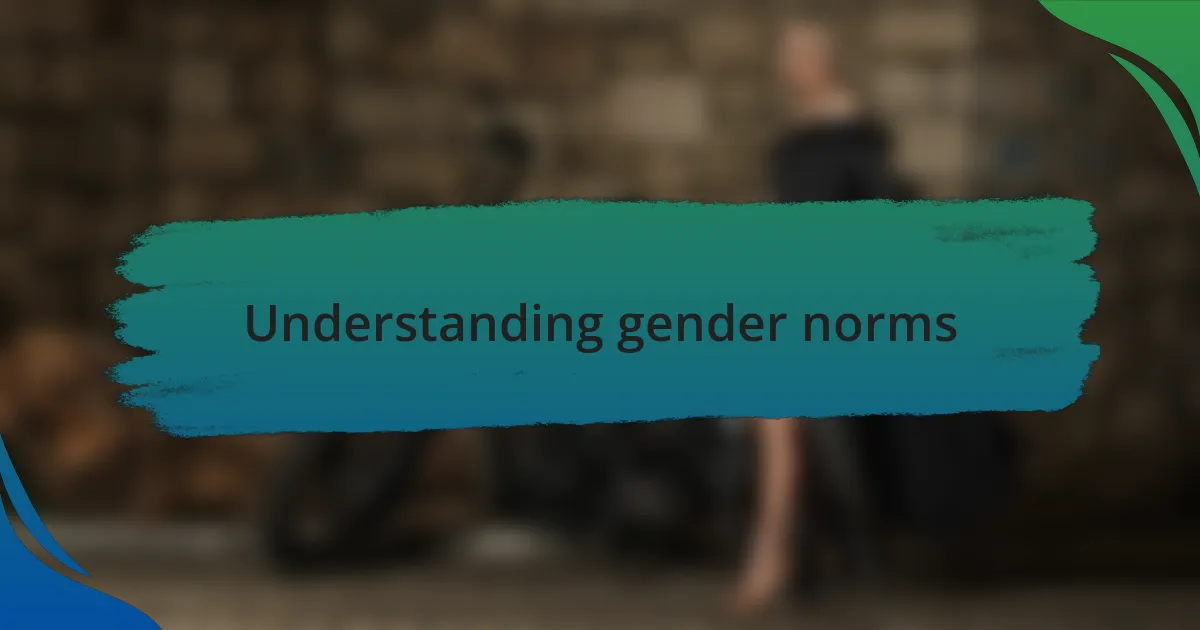
Understanding gender norms
Gender norms are the societal expectations surrounding how individuals should behave based on their perceived gender. Growing up, I often noticed how my peers were pigeonholed into specific roles—boys were encouraged to play rough while girls were nurtured to be caretakers. This made me wonder: What if we didn’t confine ourselves to these definitions?
As I navigated my teenage years, I started to challenge these norms. I vividly remember a day when I chose to wear what was labeled as “boys’ clothing” to school. The stunned reactions from classmates made me feel a mix of empowerment and anxiety. In that moment, I understood how deeply ingrained these expectations were and how they could be both liberating and restricting.
Reflecting on those experiences, I realize that gender norms not only shape our identities but also dictate our interactions with the world. How many of us have felt the pressure to conform, despite knowing it didn’t represent who we are? That realization is pivotal in understanding the need for challenging these constructs in pursuit of authenticity and self-expression.
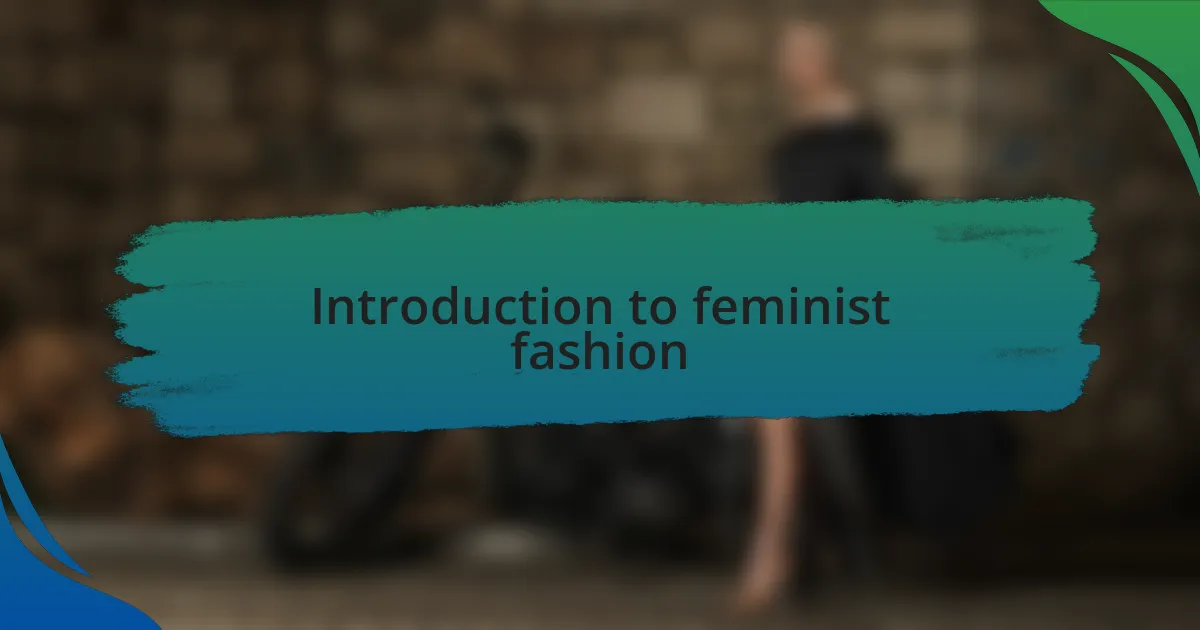
Introduction to feminist fashion
Feminist fashion is more than just clothing; it’s a powerful statement about identity and liberation. I remember the first time I stepped into a thrift store and discovered a vintage blazer that felt like a step away from traditional femininity. The realization hit me then – fashion could be an act of rebellion, a way to express who I truly am without conforming to societal expectations.
This movement encourages individuals to embrace clothing that resonates with their identity, irrespective of gender labels. I often find myself pondering how a simple dress or a tailored suit can challenge perceptions and force conversations about gender equality. For me, this isn’t just about what I wear; it’s about how I present myself to the world and how I refuse to be categorized by outdated norms.
Feminist fashion seeks inclusivity, celebrating styles that defy limitations and empower every person. When I don outfits that blend what society deems “feminine” and “masculine,” I feel a sense of freedom that’s both exhilarating and affirming. Isn’t that what fashion should be about—allowing us to express our unique stories and break the chains of conformity?
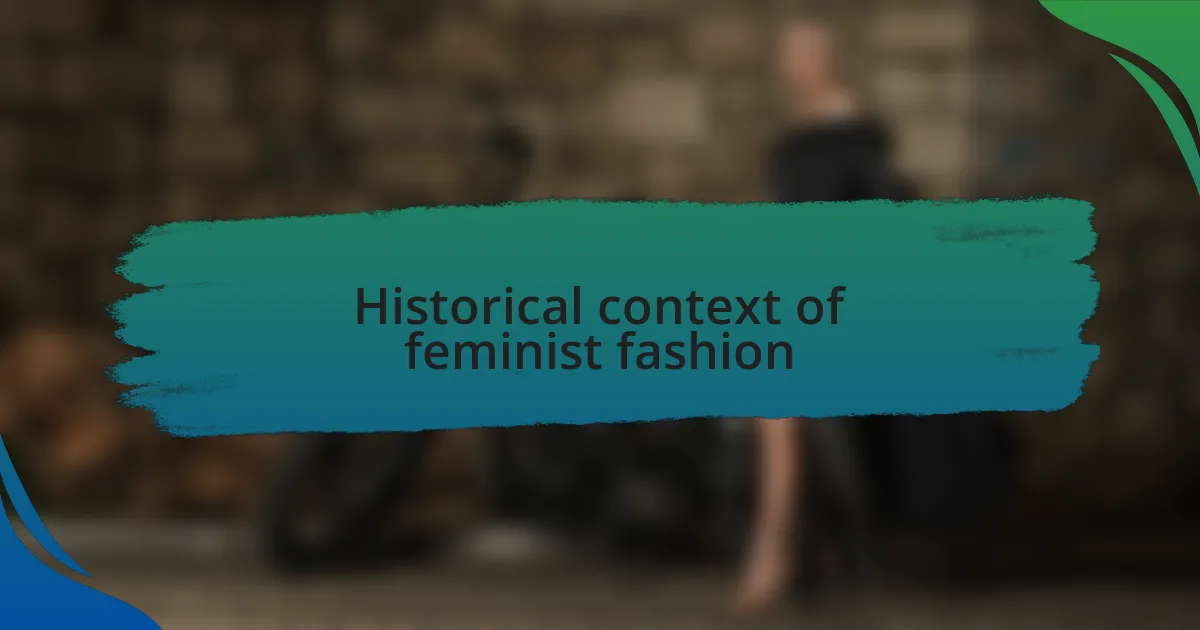
Historical context of feminist fashion
The roots of feminist fashion can be traced back to the late 19th and early 20th centuries, when women began to fight for their rights, including the right to vote. I often think about how the suffragettes donned white dresses to symbolize purity while wielding their banners of equality; they understood that clothing could serve as both a shield and a weapon. This movement challenged the idea that a woman’s place was solely in the home and began opening doors for women to express their individuality.
As we moved into the 1960s and 70s, the women’s liberation movement brought about radical shifts in fashion. I remember sifting through old magazine clippings and seeing how women embraced pantsuits, miniskirts, and bold patterns as statements of freedom and rebellion against traditional gender roles. It’s fascinating how fashion became a visual language for expressing newfound independence—it’s almost as if each garment told a story of resistance.
Fast forward to today, and the legacy of those early feminist movements is evident in how fashion continues to evolve. Whenever I see a designer challenge gender norms—like the use of men’s fabrics in women’s clothing—I can’t help but smile, knowing that this is a continuation of a long-standing battle for self-expression. Isn’t it incredible how fashion not only reflects societal changes but also actively participates in shaping them?
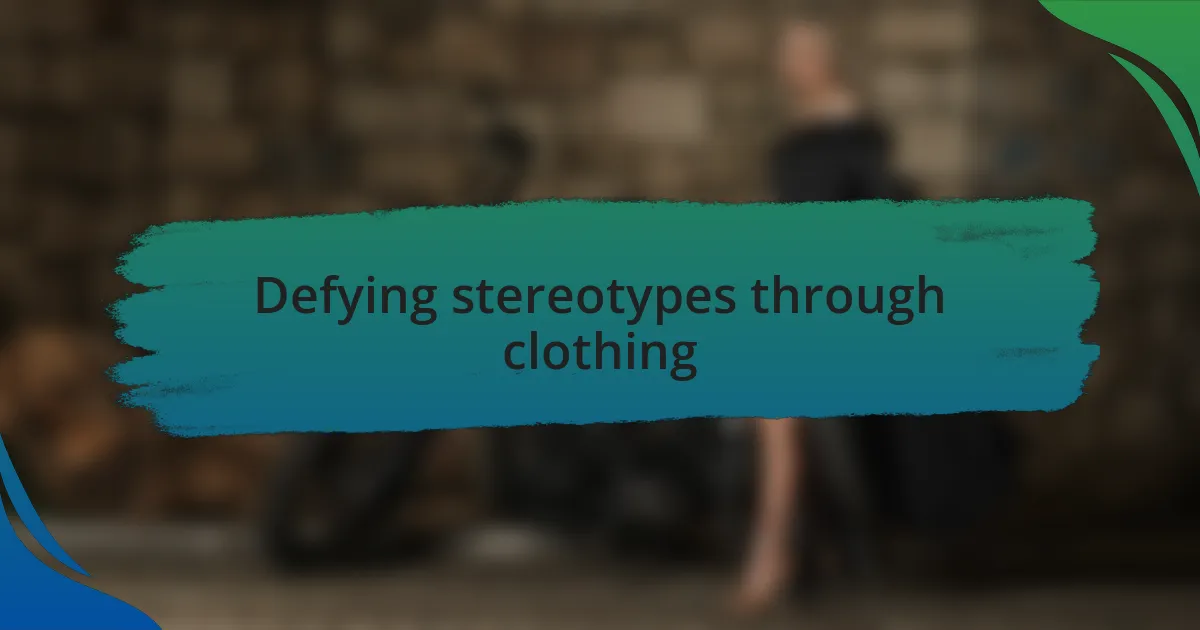
Defying stereotypes through clothing
Defying stereotypes through clothing is about more than just trends; it’s a bold statement of who we are. I recall the moment I slipped into a tailored blazer that was traditionally designed for men, feeling a surge of empowerment. I wasn’t just wearing a piece of clothing; I was actively confronting the notion that professional attire must adhere to outdated gender expectations. It made me ponder—what other ways can we use fashion to challenge the norms that often limit us?
The beauty of clothing lies in its versatility. For instance, when I wear skirts paired with combat boots, I feel a blend of femininity and strength that beautifully defies categorization. This mix not only disrupts conventional ideas about what women should wear, but it also invites conversations about comfort and identity. Have you ever thought about how your outfit can open up dialogues about gender, challenging societal views one garment at a time?
I truly believe that every choice we make in our wardrobe can be a form of resistance. When I see young people embracing androgynous styles, it fills me with hope. Each outfit shared on social media becomes a rallying cry for authenticity and individual expression. It makes me ask: how can we all contribute to this movement, using clothing as a canvas to paint our most authentic selves?
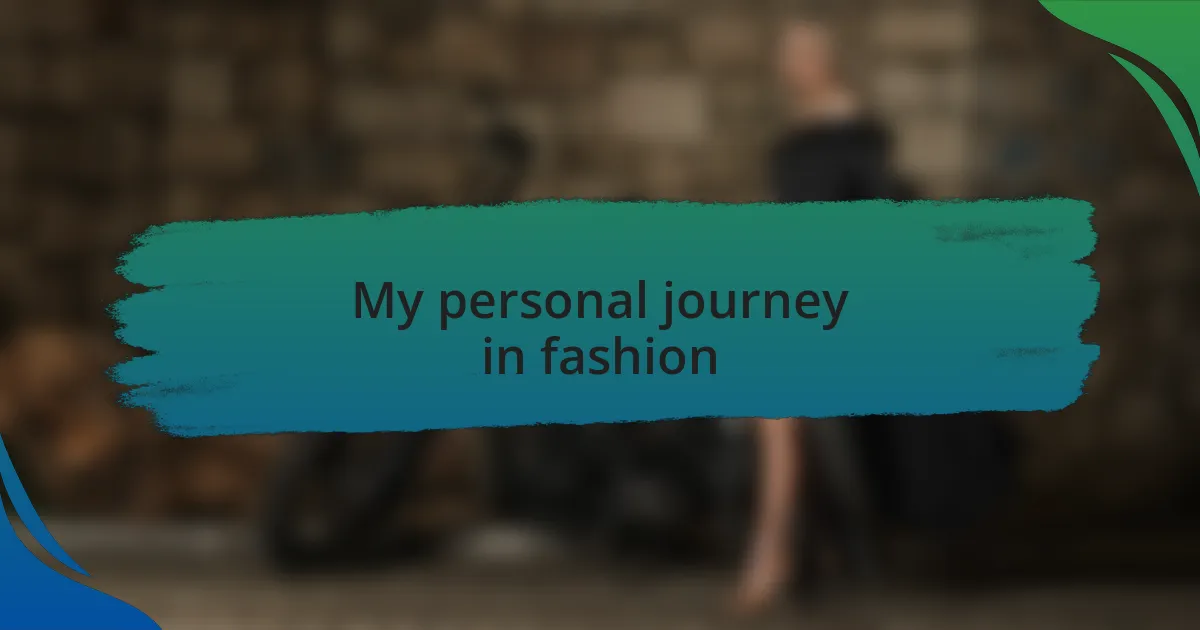
My personal journey in fashion
Fashion for me has always been a journey of self-discovery. I vividly remember my first pair of high-waisted, oversized jeans—an item I bought after realizing I didn’t need to fit into the tight silhouettes often marketed to women. Each time I wore them, I felt liberated, as if every inch of extra fabric was a declaration of my refusal to conform to prescriptive ideals about femininity. How often do we let fabric define who we are rather than reflecting our true selves?
Then there was that moment at a family gathering when I chose a brightly colored jumpsuit instead of the expected dress. The surprised looks I received made my heart race; I felt like I was challenging not only their expectations but my own fears of judgment. In that instant, I embraced my individuality, letting the bright colors express joy and confidence, which often gets overlooked in traditional attire. Isn’t it fascinating how a single choice can shift perceptions and ignite conversations?
I find that my wardrobe is a constant reminder of my evolution. Sometimes, I sift through my closet and see clothes that hold memories—dresses I no longer wear but that once made me feel invincible—and I think about how each piece tells a story of my journey. It makes me reflect on how our clothing choices shape not only how others see us but how we see ourselves. What stories do your clothes tell about your journey, and how might they inspire you to take a step further in defying societal norms?
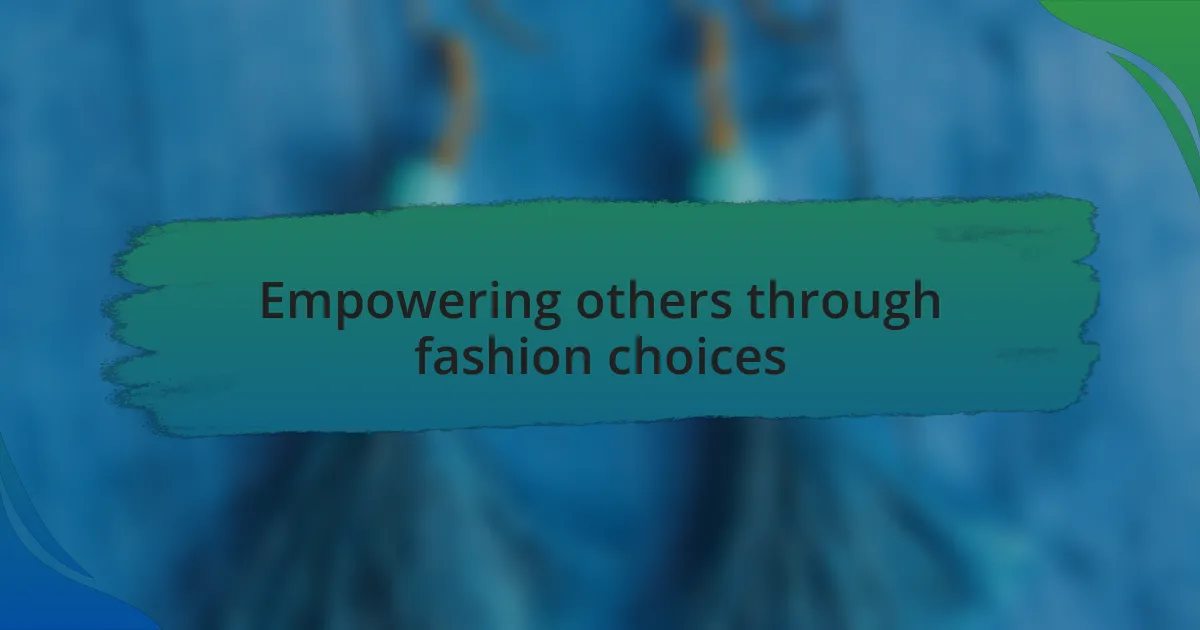
Empowering others through fashion choices
Fashion has the incredible power to uplift and inspire those around us. I remember attending a community event where a friend wore a tailored blazer with vibrant patterns, breaking away from the traditional, monochrome look often expected in such settings. Her bold choice sparked conversations, encouraging others to embrace their unique styles, proving that when we dare to express ourselves, we inspire others to do the same. Have you ever noticed how a striking outfit can create an atmosphere of confidence?
Every piece in our wardrobe carries a message, whether we intend it or not. I once wore a pair of combat boots to a formal gathering, purposefully contrasting societal expectations of what should be deemed appropriate. The raised eyebrows and whispers turned into compliments as the night progressed, demonstrating how fashion can become a tool for empowerment. How refreshing it is to realize that our choices can challenge the status quo and encourage others to step outside their comfort zones!
Ultimately, we have the potential to create a ripple effect through our fashion choices. A simple accessory, like a colorful scarf or a statement necklace, can provoke dialogue about identity and gender norms. I recall gifting a friend a quirky tie in support of her journey, and seeing how confidently she wore it inspired others to question their own choices. Isn’t it exciting to think that by making intentional fashion choices, we can foster a community that celebrates individuality and self-expression?